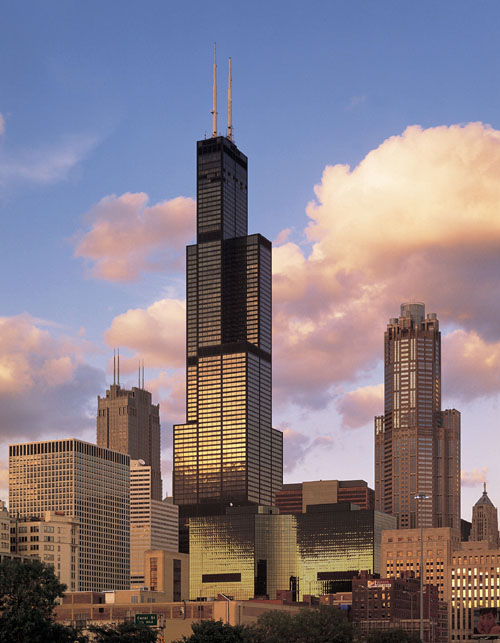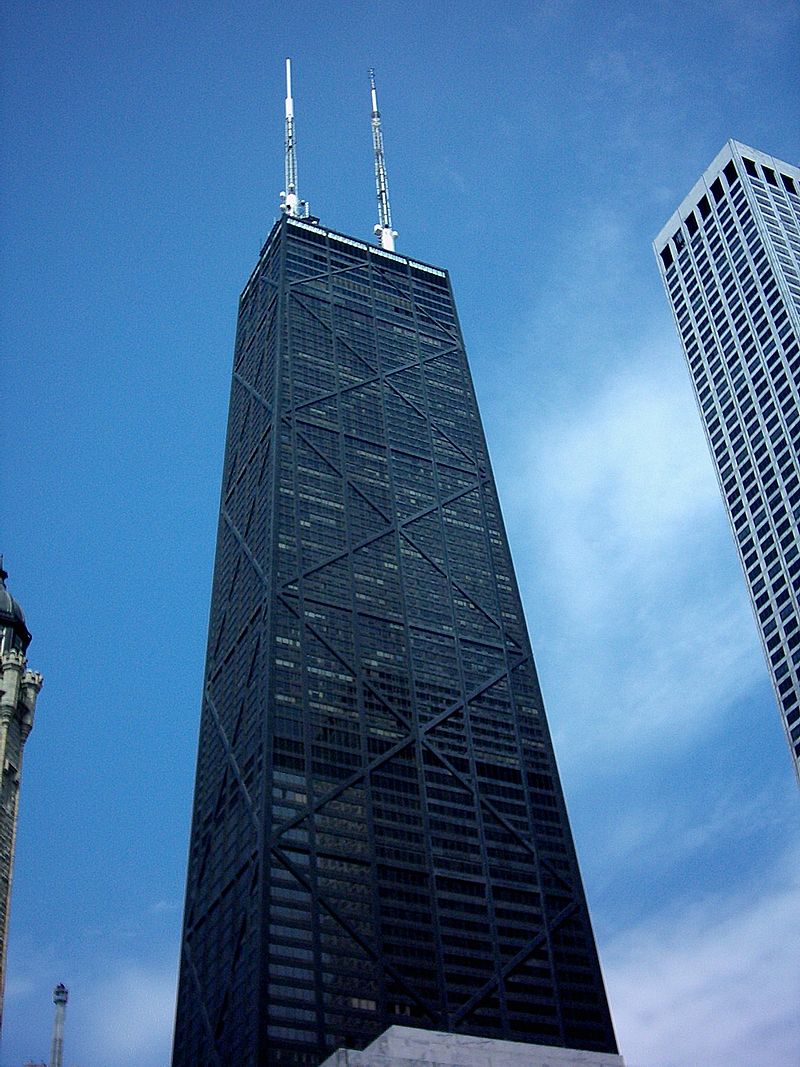Biography
Fazlur Rahman Khan (1929 – 1982)
Fazlur Rahman Khan is an American civil engineer, author of the Chicago-based skyscrapers Willis-Tower and John Hancock Center. He was a native of Bangladesh, who worked for the architectural firm Skidmore, Owings, and Merrill. In the 1960s he became the most influential specialist in the structural design of high-rise buildings.
Chicago as Architectural Center
By the end of the XIX century, the center of the economic life of the country is Chicago. It is here that the foundations of the architecture of the “Chicago School,” the bright page of the prehistory of modern architecture, were laid. Its beginning is associated with the fire of 1871, almost completely destroyed Chicago. The leader of this school was Louis Sullivan (1856-1924). Studies of functional and constructive problems of high-rise construction attempt to find the logic of constructive shaping of new objects occupied him no less than the design itself.
The metal frame that facilitated the rapid restoration of the city after the fire was applied during the restoration of Chicago. The construction was accompanied by a huge jump in the growth of land prices, so the construction was conducted only by multi-story buildings. The development of multi-story construction was facilitated by the invention of the elevator, the use of a metal frame and the use of a water-closet.
With the construction of skyscrapers, the design and construction and technological areas of activity in designing and erecting an edifice are becoming much more complicated. An independent profession of a civil engineer, one of whose representatives were and whose name is directly related to the development of Chicago architecture stands out from the traditional architectural profession.
Fazlur Rahman Khan Biography
Fazlur Khan was born in Dhaka, on the territory of modern Bangladesh. He studied at the University of Calcutta and Dhaka. After graduating from Dhaka University in 1951, he won the Fulbright Award for talented students from the colonies, which allowed him to continue his education in the US (Illinois State University). Within three years Fazlur Khan received three diplomas – master and doctor in structural design and a master of theoretical mechanics.
In 1955 he began to work at Skidmore, Owings, and Merrill and has since lived in Chicago. Passing all the steps, by 1970 he became a full partner of the company (and remained the only partner “from engineers”). During this time, he developed and for the first time implemented standard schemes of load-bearing structures, which became standards in high-rise construction such as “carrier tube,” “tube in tube,” “tube with inclined bars,” etc. Thanks to Khan, it became possible to build high-rise buildings of complex shapes such as pyramids, irregular prisms, etc. (previously the choice of forms was limited to rectangular prisms).
He is a laureate of many professional awards during his life and posthumously, for example, “Builder 1972” according to Engineering News-Record. The square in Chicago, adjacent to Sears Tower is named after Fazlur Khan, and his statue was installed in the tower itself in 1987.
He died on March 27, 1982, not surviving 6 days before the 53rd anniversary. He was buried in Chicago, in Grassland Cemetery.
Innovative Steel Structures
Classics of skyscraper construction presuppose the presence of a steel frame inside the building, which is assembled like a lattice. The ceilings are made of concrete slabs that make up the floor and ceiling, and on the outside, the edifices lined with glass. These external walls are called “curtain wall”; it does not hold anything, but only closes the insides of the structure from adverse weather conditions.
In the first half of the last century, almost all significant skyscrapers, including the Empire State Building, the Chrysler Building, and others, were built on a steel frame. They had the only significant drawback; it is their traditional rectangular shape.
Over time, the engineers found out that steel has a few not very pleasant properties. First, it is subject to temperature variability; for example, if a fire starts in the building, the frame softens and deforms. So, the official version of the destruction of the “Twin Towers” in America is precisely the breaking of the strength of the frame due to temperature. Secondly, steel, like any metal, is susceptible to corrosion. Third, steel is very expensive. And fourthly, as with any material, steel has an extremely effective height – very high buildings can not be constructed on this principle.
Therefore, the American engineer Fazlur Khan proposed to build skyscrapers in a stem-shell scheme. It provides for the presence in the center of the edifice of a massive concrete trunk with thick walls, and along the edges – large columns wrapping it. This method, first, allows edifice constructions of enormous height, and, secondly, to erect skyscrapers of almost any shape.
He developed and realized for the first time the standard schemes of load-bearing structures, which became standards in high-rise construction such as the “carrying tube,” the “tube in the tube,” the “tube with inclined bars,” etc. It was a genuine revolution in the design of high-rise buildings on a metal frame. These innovations opened up scope for imagination: skyscrapers of complex shapes such as pyramids, irregular prisms and others appeared.
The Most Significant Projects
Fazlur Khan personally designed dozens of buildings, including:
- 1964 – DeWitt-Chestnut Apartments, Chicago. This is a 43-storey residential edifice made of monolithic reinforced concrete. It was the first example of a “carrying tube” design, in which the supporting columns are located only along the perimeter of the building.
- 1966-1969 – John Hancock Center, Chicago. At the heart of the project was the offer of Mikio Sasaki, in those years still a student. This is the first high-rise edifice in the world in the form of a truncated pyramid with diagonal bars; at the time of construction, it was the second tallest edifice the world.
- 1970-1971 – One Shell Plaza in Houston (the world headquarters of Shell). At the time of construction, it was the highest reinforced concrete edifice the world (218 meters) and the first sample of the “tube in the tube.” The variable pitch of the columns of the “carrying tube” gives the impression of waves running along the wall.
- 1970-1973 – Willis Tower, Chicago. At that time and until 1998 it was the tallest edifice the world.
- 1981 – Hajj Terminal at the airport of King Abdul-Aziz, Jeddah (Aga Khan Prize in 1983, posthumously). At the heart of the edifice are 10 identical modules with 45-meter facades, united by a shopping arcade. At the time of construction, the roof hood of the main building, designed for a daily flow of up to 80,000 passengers, was the largest in the world.
There are two significant projects of this architecture that are worthy of special attention.
Willis (Sears) Tower

For three years they managed to create an edifice’s amazing height – four hundred and forty-three meters in the form of one hundred and ten floors. For twenty-five years, this skyscraper was the tallest edifice the world. Now he took the honorable 2nd place in height in the United States and 10th in the world. On July 16, 2009, the Sears Tower was renamed the Willis Tower. In this building, Fazlur Khan used a shell-diaphragm constructive system. A distinctive feature is that the edifice consists of 9 steel tubes of square section, forming a large square in the base; the design is designed in three levels, gradually tapering upward. There are 2 TV antennas on the roof (the antennas’ end reaches 527.3 m). On the 103rd floor, there is an observation deck with balconies.
John Hancock Centre

The skyscraper project, which at that time was the second tallest edifice the world, was originally conceived at the end of 1964 and belonged to developer Jerry Wolman. In the future, the project is financed by the insurance company John Hancock Mutual Life Insurance Co. The peculiarity of the edifice is a hollow construction resembling a huge rectangular column. In the building, designed by Fazlur Khan himself, a shell structural system with diagonal connections of supporting structures located along the outer contour was used.
Both of these buildings realize the concept of a bearing steel tube, which is used today for the construction of the highest buildings, such as the Burj Khalifa in Dubai.





